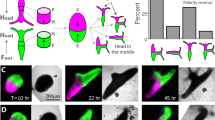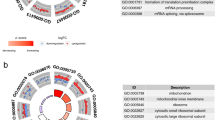Abstract
REGENERATION of Hydra littoralis is usually strictly polarized in the sense that distal structures such as hypostome and tentacles always form at the distal cut surface whereas proximal structures such as the basal disk always form at the proximal cut surface. The physiological basis of this polarity is unknown, but most theories of hypostome regeneration imply that the hypostome forms at the high point of a gradient which runs from the hypostome to the basal disk (disto-proximally), and defines the polarity. The nature of this gradient is unknown but it is variously regarded as one of metabolic activity1, growth substances2, or inhibitor threshold3. Polarity need not necessarily involve a gradient. If, for example, the transfer of positional information4 were polarized in a disto-proximal direction, the distal end could be specified as that region which received no positional information from other cells. Another type of model could operate if each cell were polarized and the absence of cells at a cut surface were recognized5. Whether a cut surface is necessary for the regeneration of distal structures is a very old problem1. Far less attention has been paid to the problem of basal disk regeneration and particularly whether it is dependent on the presence of a functioning hypostome.
This is a preview of subscription content, access via your institution
Access options
Subscribe to this journal
Receive 51 print issues and online access
$199.00 per year
only $3.90 per issue
Buy this article
- Purchase on Springer Link
- Instant access to full article PDF
Prices may be subject to local taxes which are calculated during checkout
Similar content being viewed by others
References
Child, C. M., Patterns and Problems of Development (University of Chicago Press, 1941).
Burnett, A. L., Amer. Nat., 100, 165 (1966).
Webster, G., J. Embryol. Exp. Morphol., 16, 105 (1966).
Wolpert, L., in Towards a Theoretical Biology, 3 (edit. by Waddington, C. H.) (Edinburgh University Press, in the press).
Wolpert, L., in Towards a Theoretical Biology, 1, Prolegomena, 125 (edit. by Waddington, C. H.) (Edinburgh University Press, 1968).
Webster, G., and Wolpert, L., J. Embryol. Exp. Morphol., 16, 91 (1966).
Clarkson, S. G., and Wolpert, L., Nature, 214, 780 (1967).
Cleland, W. W., Biochemistry, 3, 480 (1964).
Descotils-Heernu, F., Quertier, J., and Brachet, J., Develop. Biol., 3, 277 (1961).
Muscatine, L., in The Biology of Hydra (edit. by Lenhoff, H. M., and Loomis, W. F.), 255 (University of Miami Press, 1961).
Webster, G., J. Embryol. Exp. Morphol., 18, 181 (1967).
MacWilliams, H. K., and Kafatos, F. C., Science, 159, 1246 (1968).
King, W., Arch. EntwMech. Org., 13, 135 (1901).
Burnett, A. L., J. Exp. Zool., 146, 21 (1961).
Brachet, J., in Advances in Morphogenesis, 3 (edit. by Abercrombie, M., and Brachet, J.) 247 (Academic Press, London, 1964).
Borisy, G. G., and Taylor, E. W., J. Cell Biol., 34, 525 (1967).
Stephens, R. E., J. Cell Biol., 32, 255 (1967).
Vacquier, V. D., and Mazia, D., Exp. Cell Res., 52, 209 (1968).
Needham, A. E., Regeneration and Wound-healing (Methuen, London, 1952).
Flickinger, R. A., Growth, 23, 251 (1959).
Author information
Authors and Affiliations
Rights and permissions
About this article
Cite this article
HICKLIN, J., HORNBRUCH, A. & WOLPERT, L. Inhibition of Hypostome Formation and Polarity Reversal in Hydra. Nature 221, 1268–1271 (1969). https://doi.org/10.1038/2211268b0
Received:
Revised:
Published:
Issue Date:
DOI: https://doi.org/10.1038/2211268b0
This article is cited by
-
Reversible Abolition of Normal Morphology in Hydra
Nature New Biology (1973)
-
The effects of sulphydryl reagents on morphogenesis in hydroids
Wilhelm Roux' Archiv f�r Entwicklungsmechanik der Organismen (1972)
Comments
By submitting a comment you agree to abide by our Terms and Community Guidelines. If you find something abusive or that does not comply with our terms or guidelines please flag it as inappropriate.



